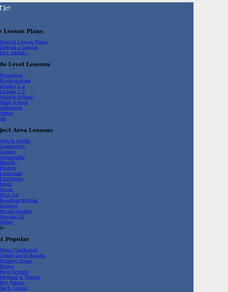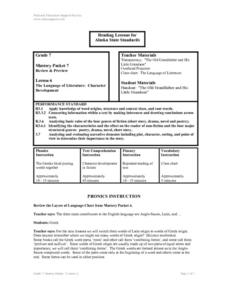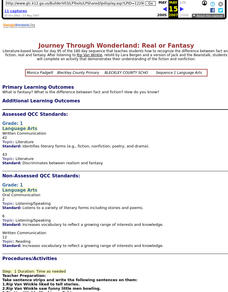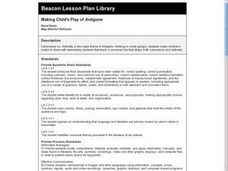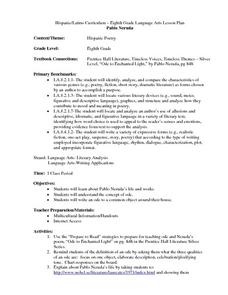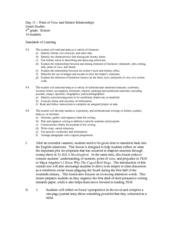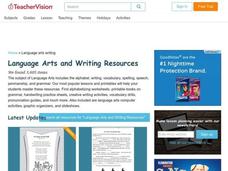Pennsylvania Department of Education
Analyzing Literary Elements in Fiction
Students analyze the characters and events in fictional writing. In this literary elements lesson, students study the meaning of the words characterization and fiction. They listen to the story Pigsty by Mark Teague, or any other book...
Curated OER
Memory in Your World
Students identify similarities and differences between machines with memory and machines without memory. They illustrate how a machine with memory might fit into the student's world.
Curated OER
Research Paper
An outline for a research paper assignment lists the expectations, grading rubric, and due dates for an extended research writing project.
Curated OER
Language Arts Exploration
While an interesting lesson idea involving the exploration of a story about an Asian American boy named Imduk, a teacher would need to have assess to the Scott Foresman reading program to make this work. If not, a teacher could use...
Curated OER
Juvenile Delinquency
Ninth graders analyze and interpret historical research by examining, analyzing, and forming opinions regarding primary resources. They compare/contrast social conflict, its causes and effects, in regards to continuity and change over time.
Curated OER
African American Traditions: Cameroonian and African-American Folktales
Young scholars compare Cameroonian and African-American folktales. In this folktales lesson plan, students participate in a jigsaw activity that requires them to read "The Owl Never Sleeps as Night," "Why the Lizard Often Nods," "Tappin,...
Curated OER
The Stinky Cheese Man and Other Fairly Stupid Tales
Sixth graders demonstrate the ability to process and evaluate content from a variety of sources and apply comprehension skills to the material read. They organize information for practical use and design and develop an informational...
Curated OER
ESL Poetry Unit
Students complete a twelve lesson unit on poetry. They read and respond to different forms of poetry, write a bio poem, complete an online WebQuest, and in small groups present lessons to the class on various types of poems.
Curated OER
Multi-sensory Writing
Students use their senses to help describe special place they have been. They write short sensory-image essay that incorporate all five of their senses, and identify sensory language while reading different pieces of literature.
Curated OER
Double Exposed Photographs
Students create double-exposed photographs, poetry, and multimedia presentations. In this artwork lesson plan, students explore cameras, poems, and other art forms to understand line, light, and other attributes that contribute to artwork.
Baylor College
About Air
Give your class a colorful and tasty representation of the components of the mixture that we call air. Pop a few batches of popcorn in four different colors, one to represent each gas: nitrogen, oxygen, argon, and carbon dioxide. The...
Curated OER
1st Grade - Act. 22: Retelling the Tiny Seed
First graders write sentences and illustrate ways seeds travel.
Curated OER
Exploring Prejudice and Text-to-Text Relationships
Tenth graders use the novel To Kill a Mockingbird to analyze relationships in society. In this literature analysis lesson, 10th graders participate in a shoe activity where they bring in one shoe belonging to someone they know and a...
Curated OER
Sonnets
Students examine the structure of sonnets. They compare and contrast them with modern day poetry. They write their own sonnet after changing the language in another sonnet to see why the author choosed certain words.
Curated OER
Greek Origins and Character Development
Seventh graders examine words of Greek origin and discuss character development in fiction. They read a list of Greek word parts and create words on a worksheet. Students then read and discuss an informational handout about character...
Curated OER
Language Arts: Character Comparison
Fourth graders, using Kidspiration, compare and contrast the two main characters from Tales of a Fourth Grade Nothing. They use a teacher-created template to describe their characters. Students then create their own character analysis.
Curated OER
Language Arts: Character Analysis
Fourth graders identify the character traits of Peter in Tales of a Fourth Grade Nothing. They find quotations in the story that illlustrate the traits. Students use Kidspiration to write their reports on a template.
Curated OER
Analysis of Character in a Short Story
Ninth graders examine a character from the short story, John Steinbeck's, "Flight." students respond to questions about the story and illustrate the character's journey.
Curated OER
Journey Through Wonderland: Real or Fantasy
First graders recognize the difference between fact and fiction, real and fantasy. After listening to Rip Van Winkle, retold by Lara Bergen and a version of Jack and the Beanstalk, 1st graders demonstrates their understanding of fiction...
Curated OER
Making a Child's Play of "Antigone"
Fourth graders make studenT books to share with elementary students that teach a universal rule that obeys both conscience and authority.
Curated OER
Pablo Neruda
Eighth graders explore the life and works of Pablo Neruda. They complete an author map concerning his personal and professional life. Students identify the key components of an ode. They write an ode to a common object around their...
Curated OER
Point of View and Mentor Relationships
Tenth graders analyze the role of mentors, point of view, and prejudice using the texts of To Kill a Mockingbird and Maya Angelou's I Know Why the Caged Bird Sings. For this literature analysis lesson, 10th graders review Scout's...
Curated OER
Haiku Poetry
Third graders write their own haiku poem after a lesson on the history and format of a haiku. In this poetry lesson plan, 3rd graders write a haiku with the correct lines and symbols.
Curated OER
I Know Why the Caged Bird Sings
Students read and analyze the novel "I Know Why the Caged Bird Sings" by Maya Angelou. They discuss the poetry and prose of the book, the importance of role models, complete a worksheet, and write a narrative using figurative language.















